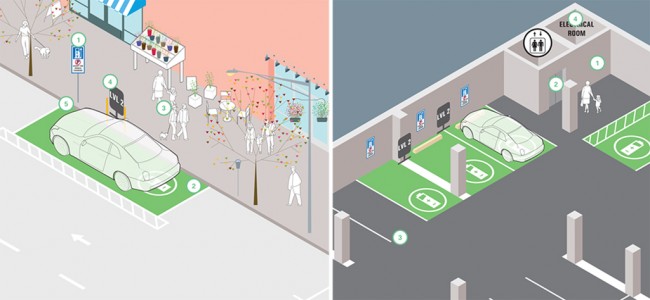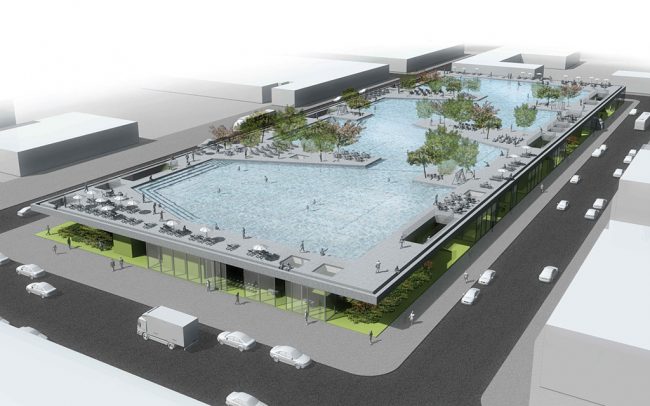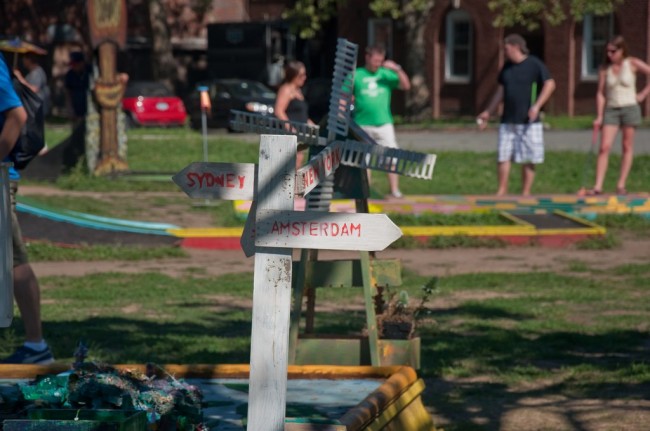
We are celebrating 15 years — and counting — of stories that are deeply researched and deeply felt, that build a historical record of what the city has been.
We are celebrating 15 years — and counting — of stories that are deeply researched and deeply felt, that build a historical record of what the city has been.

Bloomberg announced a pilot composting program (L) and a proposed ban on styrofoam in his State of the City address. | Images via Frank Farm and dotpolka
STATE OF THE [_____]
Public officials were busy this week proclaiming the state of their charges. In the first State of the Union address of his second term, President Obama laid out a domestic agenda thick with legislative and executive efforts to raise the minimum wage, insource manufacturing, strengthen gun control, stem climate change, create universal pre-school education, and repair the nation’s ailing infrastructure. Next City and Planetizen analyzed the address and have found that many of the proposals bode well for cities. Transit advocates hailed the announcement of the Fix-it-First initiative, which could lead to the repair of some of the nation’s 70,000 structurally deficient bridges, in addition to mentions of high speed rail and a program to spur private investment in infrastructure. The keystone of the President’s jobs plan continued to focus on revitalizing manufacturing, a prospect some argue would not provide the good jobs necessary to further improve the economy. Watch the “enhanced” speech here, complete with supplementary charts and facts.
On Monday, City Council Speaker Christine Quinn’s State of the City address focused largely on the city’s affordability crisis. She pledged to “keep New York City what it has always been, a place where opportunity is given, not just to those who can afford to buy it, but to those willing to work for it.” The major components of her vision include the creation of 40,000 new affordable apartments in the next decade and an incentive program for private developers to create or retain middle-income apartments in exchange for tax credits. Read the speech here.
Bloomberg’s State of the City address, the last of his 12-year stint in office, touted a number of environmental initiatives, among them a ban on the use of styrofoam packaging, an expansion of the number of electric vehicle charging stations in the city, an increased focus on recycling, and a pilot program to collect and compost food waste on Staten Island, a step cities such as San Francisco and Seattle have already taken. The mayor defended real estate megaprojects, which have thrived under his encouragement as necessary to revitalize the city’s economy and ensure its competitive status globally. He also vowed not to abandon the waterfront, an answer to questions of the wisdom of continuing to encourage waterfront development — which has boomed during his tenure — in the wake of the devestation of Hurricane Sandy. Watch the speech here.

Street and garage electric vehicle charging station designs | Images via WXY Architecture + Urban Design
ELECTRIC VEHICLE CHARGING STATIONS
Building a new infrastructure from the ground up for electric vehicles will no be easy task, and fundamental questions remain about how to design and expand the nation’s electric vehicle infrastructure. A new report by WXY Architecture + Urban Design could help address one major question that has yet to be answered across the industry: how to design public charging stations. The report, part of a larger series sponsored by the US Department of Energy and NY State Energy Research and Development Authority, offers design guidelines for implementing an electric car charging infrastructure, identifying 22 design elements across the categories of installation, access, and operation and proposing design solutions for implementation. The report proposes clean and simple solutions that could easily be standardized, including a universal symbol for charging stations, similar to the ubiquitous handicap symbol.
NOT-SO-AFFORDABLE HOUSING
A new report by the Association of Neighborhood and Housing Development, a research and advocacy group, found that two thirds of the city’s recently developed affordable housing was out of the price range for many of its supposed beneficiaries. Many of these units, part of the Bloomberg administration’s push to build or preserve 165,000 affordable units by 2014, start at prices above the median income for their neighborhood and are therefore unaffordable according to some critics. The Bloomberg administration claims that the units fill a gap for residents with incomes too high to qualify for public housing but who still can’t afford market rate apartments. Moses Gates, an author of the report, asserts “if the housing built is not actually affordable to the people living in the neighborhood, the affordable housing is just housing.” The report comes on the heels of Christine Quinn’s own plan to keep housing affordable in the city, which would include a 30-year cap on real estate taxes for landlords who renew participation that sets aside 20% of apartments in new developments for below-market rents. The cap, a variation on a proposal the industry advocacy group the Real Estate Board of New York developed, was deemed too generous a deal for developers by Bloomberg in 2011, leading Public Advocate Bill De Blasio, to jab “when the mayor says it’s fiscally irresponsible to give so much money to the wealthy, you know you’ve got a problem.” Quinn contends that the cap is necessary to keep developers from abandoning the affordable housing program.
CITIES HEAT THE HINTERLANDS
Residents of urban areas produce less carbon dioxide per capita than residents in less dense areas, due to smaller square footage of living spaces, ability to use mass transit, and building efficiencies only possible through greater density. But despite the push towards greater density to combat global climate change, cities may still be raising temperatures in other ways. According to a 2012 study by scientists at Florida State University, the National Center for Atmospheric Research, and the Scripps Institution of Oceanography, human activities in urban areas can cause temperature increases up to 1,000 miles away. The study didn’t focus on the Heat Island Effect, when heat is absorbed by hard surfaces and trapped in urban areas, but rather heat produced by buildings and vehicles (much more densely packed in urban areas) that rises into the atmosphere. There it is dispersed by natural movements of the global jet stream and can affect temperatures far beyond the urban areas themselves.

Flood Courts Gowanus, the winner in the Community Programming Category | Image from Gowanus by Design via Bustler
WATER_WORKS WINNERS
This week, Gowanus by Design (GbD) announced winners for Water_Works, a design competition for a community center and infrastructure to prevent combined sewage overflow into the Gowanus Canal. The community-based urban design advocacy group sought designs that “explore water’s role in recreation, quotidian uses, and in contaminated environments, and demonstrate how a new community center and retention facility represent a more progressive view of our city’s infrastructure.” Given the complexity of the competitions goals, the jury decided that no one entry adequately addressed all of the site and programs complex issues, so winners in three categories were chosen: Urban Ecology, Architectural Design, and Community Programming. The competition is the second hosted by GbD; explore the winning entries from the first, “Connections: Gowanus Lowline,” in this UO piece.
SANDY UPDATES
According to a report released by the National Hurricane Center on Tuesday, Sandy is officially the second-costliest storm in the nation’s history. Over 650,000 homes were damaged or destroyed, while over eight million households lost power in the Untied States. With the Sandy Relief Bill signed into law at the end of January, funds are finally flowing into the region for recovery. The promised funding is not, however, sacred. Shaun Donovan, Secretary of Housing and Urban Development and head of the Sandy rebuilding effort for the White House, cautioned that sequestration cuts set to go into effect March 1st would reduce the aid by approximately five percent or $800 million.
In New York, some continue to fight to get their homes back in order. Many homeowners are still waiting to receive their relief checks amounting to around $200 million, which have been held up due to a complicated financial process. Others have an entirely different battle: mold. City politicians are seeking federal assistance in addressing the increasingly dangerous mold infestation in many of the surviving structures that were flooded by Sandy.
New York City Housing Authority (NYCHA) Chairman John Rhea admitted many of NYCHA’s shortcomings during Sandy at a panel at the New School on Tuesday, one of his first public appearances since the storm. He announced the stark lessons learned from Sandy, which will guide NYCHA moving forward and towards making its buildings more resilient so residents can safely remain during disasters.
The Army Corps of Engineers announced their plans to restore the beaches in the Rockaways destroyed in the storm. Reconstruction of the dunes will begin in early summer, with the whole process complete in four to six months. While construction of massive storm mitigation strategies for the future are all still in the preliminary stages, Michael Kimmelman of the New York Times — after Governor Cuomo announced his intention to buy back private property in high-risk areas — urges consideration of the Netherlands’ model of purchasing private land as reservoirs for controlled flooding.
EVENTS AND STUFF TO DO

A hole on FIGMENT’s Mini Golf on Governors Island last summer | Image via aloucha
CALL FOR PROPOSALS: MINI GOLF ON GOVERNORS ISLAND
Governors Island has become one of New York’s greatest summertime assets, including the free artist-designed mini golf course created by FIGMENT, now in its sixth year. The theme for this year’s golf course is “State of the Art,” which submitting artists are asked to interpret “with as much diversity of perspective as possible… literally, metaphorically, or with as much poetic license as you like.” The deadline to submit proposals is March 1st; find more details at the FIGMENT 2013 website.
TROPFEST NYC 2013
Tropfest, the world’s largest short film festival, started 21 years ago in Sydney and now sees over 100,000 viewers every year. Last year the festival went international with over 10,000 people packing Bryant Park for Tropfest New York. Now planning for their second year, Tropfest is inviting filmmakers of all levels of experience to submit films for this June’s festival. The winner will take home $20,000 cash and be set up with a week of meetings with film execs in Los Angeles. The films must be no longer than 7 minutes (including titles and credits), made specifically for Tropfest NY 2013 and be a world premiere (including online), and include the annual Tropfest Signature Item, which for 2013 is ‘Bridge’ (which can be included in any way the filmmaker chooses). The entry deadline is May 9th, see the Tropfest NY website for more details.
RUN CANOE FOR CHARITY
The Bronx River Alliance is working hard along the Bronx River, an often forgotten New York City waterway with an abused industrial past but hopeful future. To help that effort, the Alliance is organizing the Starlight 5k Canoe Challenge, a ten-team canoe race to raise money to help support their efforts. Starting at Starlight Park, the newest park on the Bronx River Greenway, the race will take place on May 11th. Sign up and find more details here.
THE FUTURE OF EAST MIDTOWN
The rezoning of Midtown East has the power to significantly change the built environment of Manhattan over the next several decades. There has been a lot of rhetoric about whether this ambitious plan by the City to reimagine an entire neighborhood is for the better or worse, but the Municipal Art Society (MAS) hopes to shed some light on the matter with “The Future of East Midtown,” a discussion of MAS’s report on the future of the neighborhood featuring presentations, a panel discussion and Q&A with the audience. Register for the event, part of a larger event called Building a Resilient and Livable New York, online here.
The Roundup keeps you up to date with topics we’ve featured and other things we think are worth knowing about.
The views expressed here are those of the authors only and do not reflect the position of The Architectural League of New York.